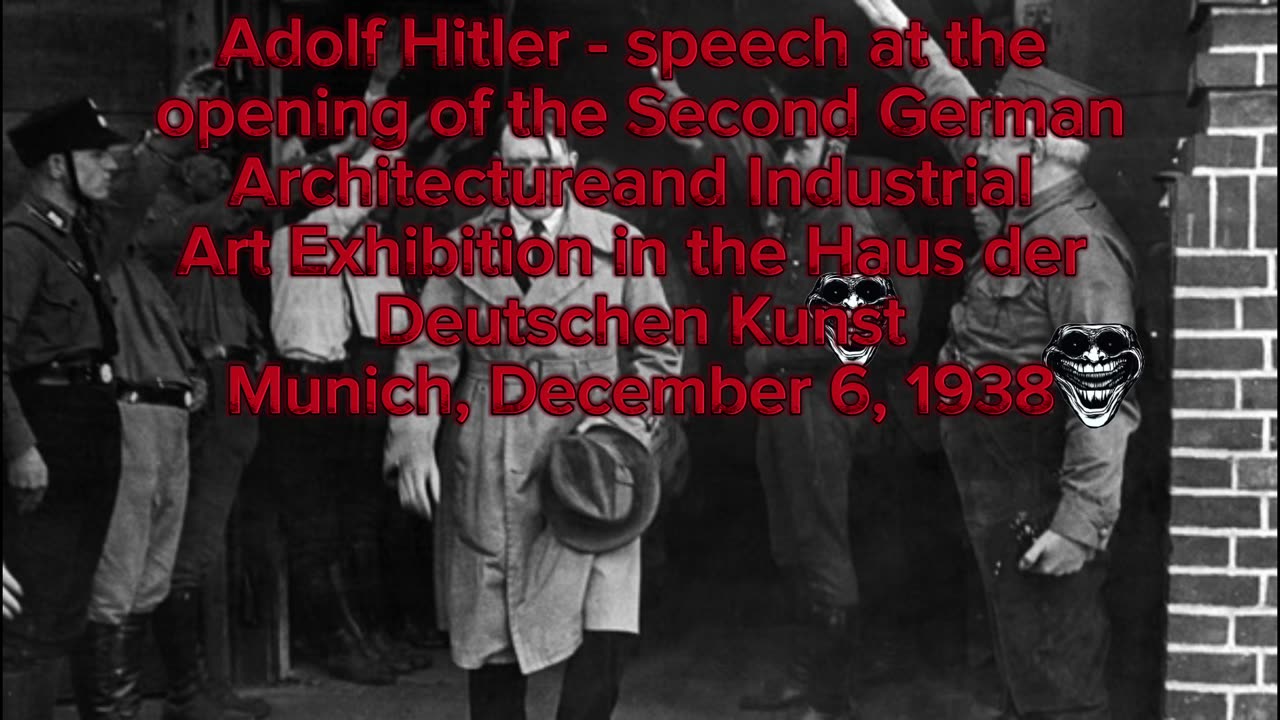Premium Only Content

Hitler's Speech – December 6, 1938
Background Leading Up to Hitler's Speech at the Architecture and Industrial Art Exhibition
Consolidation of Power: By December 1938, Adolf Hitler had firmly established his control over Germany. The Nazi regime had dismantled democratic institutions, and Hitler's totalitarian state was in full force.
Economic Recovery: Under Nazi rule, Germany experienced significant economic recovery and rearmament, largely driven by state intervention and military spending. This economic upswing contributed to the regime’s popularity.
Cultural Propaganda: The Nazis placed a strong emphasis on cultural propaganda, using art and architecture to promote their ideology. The Haus der Deutschen Kunst (House of German Art) in Munich was a key venue for showcasing Nazi-approved art and architecture, intended to reflect Aryan ideals and the regime’s vision for Germany.
International Tensions: In the international arena, tensions were rising. The annexation of Austria (Anschluss) in March 1938 and the Munich Agreement in September 1938, which allowed Nazi Germany to annex the Sudetenland from Czechoslovakia, were significant events that set the stage for further expansionist policies.
Hitler's Speech at the Opening of the Second German Architecture and Industrial Art Exhibition – December 6, 1938
On December 6, 1938, Adolf Hitler delivered a speech at the opening of the Second German Architecture and Industrial Art Exhibition in the Haus der Deutschen Kunst in Munich. This speech highlighted the regime's views on art, architecture, and their role in shaping the new Germany.
Key Points of Hitler's Speech:
Role of Art and Architecture: Hitler began by emphasizing the vital role of art and architecture in expressing the cultural and ideological values of a nation. He argued that true art should reflect the spirit of the people and the nation’s historical and cultural heritage.
Critique of Modernism: A significant portion of the speech was devoted to critiquing modernist and avant-garde art, which Hitler and the Nazi regime deemed degenerate. He condemned these art forms for their perceived lack of connection to the people and their traditions, labeling them as products of cultural decay.
Promotion of Traditionalism: Hitler promoted a return to classical and traditional artistic forms, which he believed embodied the purity and strength of the Aryan race. He argued that these styles were timeless and universally comprehensible, unlike the abstract and experimental forms of modernism.
National Identity: The speech emphasized the importance of art and architecture in fostering a strong national identity. Hitler asserted that buildings and artworks should inspire pride and unity among the German people, reflecting the values and aspirations of the nation.
State Support for the Arts: Hitler highlighted the Nazi regime’s commitment to supporting the arts that aligned with its ideology. He mentioned the efforts to promote artists and architects who were creating works that resonated with the regime’s vision and the establishment of institutions like the Haus der Deutschen Kunst to showcase such works.
Future Vision: Hitler outlined his vision for the future of German art and architecture. He called for the creation of monumental works that would stand as symbols of the new Germany, projecting power, order, and cultural superiority.
Analysis:
Hitler’s speech at the opening of the Second German Architecture and Industrial Art Exhibition was a significant articulation of the Nazi regime’s cultural policies and its vision for the role of art and architecture in the Third Reich.
Cultural Control: The emphasis on traditionalism and the rejection of modernism were central to the regime’s efforts to control cultural expression. By promoting specific artistic styles, the Nazis aimed to ensure that art served as a tool for propaganda and ideological reinforcement.
National Identity and Unity: The focus on art and architecture as expressions of national identity was intended to foster a sense of unity and pride among Germans. By linking cultural achievements to Aryan ideals, Hitler sought to solidify the connection between the regime and the nation's historical and cultural legacy.
Rejection of Degenerate Art: The condemnation of modernist art was part of a broader campaign against what the Nazis termed "degenerate art." This campaign aimed to purge German culture of influences deemed foreign or corrupting, reinforcing the regime’s racist and anti-Semitic policies.
State Patronage: The speech underscored the regime’s role in patronizing and promoting artists who aligned with its vision. This patronage was designed to create a cultural elite loyal to Nazi ideals and to produce works that would serve the regime’s purposes.
Future Vision: Hitler’s call for monumental art and architecture reflected his desire to leave a lasting legacy. These grand projects were intended not only to inspire the current population but also to impress future generations with the grandeur and permanence of the Nazi state.
Overall, Hitler’s speech on December 6, 1938, at the Haus der Deutschen Kunst was a clear statement of the Nazi regime’s cultural policies. By promoting traditionalism, rejecting modernism, and emphasizing the role of art and architecture in shaping national identity, Hitler sought to align Germany’s cultural output with the ideological goals of the Third Reich. This speech was an important part of the regime’s efforts to use culture as a means of consolidating power and reinforcing its vision for the new Germany.
-
 LIVE
LIVE
Viss
1 hour ago🔴LIVE - Taking Wins all Over The PUBG Battleground!
132 watching -
 6:23
6:23
Talk Nerdy Sports - The Ultimate Sports Betting Podcast
1 hour agoGood Friday, Bad News for the Books: Riste’s Cold-Blooded Card
22 -
 1:04:25
1:04:25
Randi Hipper
1 hour agoXRP ABOUT TO SHOCK YOUR PORTFOLIO! MAJOR RIPPLE NEWS
7.79K2 -
![Tulsi Gabbard Declassifies Biden Admin Docs Targeting ‘Domestic Terrorism’[EP 4524-8AM]](https://1a-1791.com/video/fww1/e3/s8/1/Z/7/-/C/Z7-Cy.0kob-small-Tulsi-Gabbard-Declassifies-.jpg) LIVE
LIVE
The Pete Santilli Show
4 hours agoTulsi Gabbard Declassifies Biden Admin Docs Targeting ‘Domestic Terrorism’[EP 4524-8AM]
1,691 watching -
 1:00:49
1:00:49
2 MIKES LIVE
2 hours agoTHE MIKE SCHWARTZ SHOW with DR. MICHAEL J SCHWARTZ 04-18-2025
7.63K -
 1:22:30
1:22:30
Game On!
16 hours ago $4.41 earnedAaron Rodgers CONFIRMS with Pat McAfee he's NOT retiring... Maybe?
84.1K1 -
 37:09
37:09
Nick Freitas
1 day agoExposing The Worst of the Swamp
82.2K40 -
 30:12
30:12
CatfishedOnline
1 day agoOnly Fans Model Drains Man's Money in Romance Scam!
45.4K17 -
 15:01
15:01
Shea Whitney
23 hours ago $4.26 earned20 *Stylish* AMAZON Closet Organization Ideas for 2025!
49.1K7 -
 16:37
16:37
IsaacButterfield
1 day ago $3.62 earnedFatTok Is Ruining Lives
35.3K32